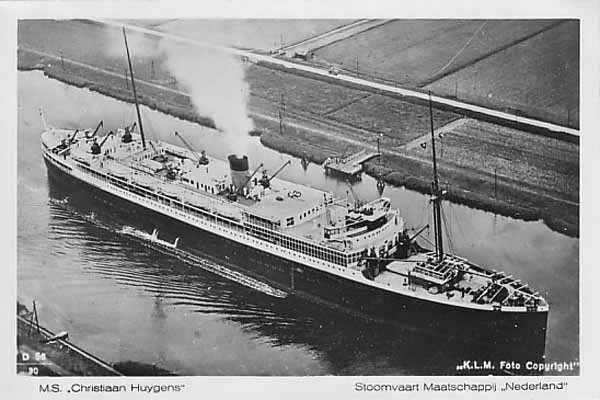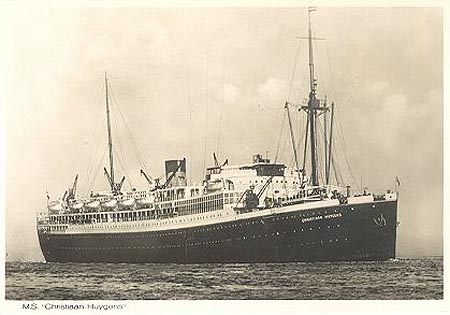
This was one of the larger ships operated by Stoomvaart Maatschappij Nederland / Netherlands Steamship Co, built by Nederlandsche Scheepsbouw-Mij, Amsterdam.
The Christiaan Huygens with accommodation for 638 passengers was intended for the Amsterdam and Batavia (Dutch East Indies) service. Its maiden voyage commenced on February 28th 1928 arriving Batavia, Dutch East Indies on March 30th 1928. The ship left for Holland on April 18th 1928 and reached Amsterdam on May 18th 1928. In each direction the ship arrived one day ahead of schedule.
It is reported that the vessel made such good time between Columbo and Suez on a return sailing from Batavia to Europe late in 1928, that even travelling at reduced speed west of Suez, the ship still arrived in Amsterdam on November 28th three days ahead of schedule.
In normal service the two single-acting two-cycle Sulzer diesel engines would operate at 115rpm giving 5,800hp each, on official trials the engines were run at 118rpm for 26 hours developing 6,300hp each.
1939 - 1945
After hostilies commenced the Christiaan Huygens was operated by the Orient Line during World War Two by the Allied forces as a troop carrier, covering 261,000 miles in this service.
On May 22 1941 the Christiaan Huygens sailed as part of a small convoy WS 8B from the United Kingdom to Suez, arriving at Freetown on June 4th 1941. Here the Christiaan Huygens detached from the WS 8B and was added to convoy WS 9A on June 20th 1941. The Christiaan Huygens was part of the convoy that called in at Durban for resupplying, though its ultimate destination is not known.
On January 12th 1942 the Christiaan Huygens sailed as part of convoy WS 15 from the United Kingdom. This convoy was attacked by U402 on January 16th 1942 with one ship sustaining damage. The convoy reached Freetown on January 25th 1942 and departed on January 29th 1942. Cape Town was passed on February 9th 1942, arriving at Durban on February 13th 1942 for refuelling. Nine ships sailed from Durban on February 22nd 1942 as convoy DM3 for Singapore, this included the Christiaan Huygens. However events overtook the convoy, Singapore had fallen to the Japanese, the new destination of Batavaia was later amended to Columbo, then Bombay as the Japanese advance through East Asia quickened. Bombay was reached on March 6th 1942.
The Christiaan Huygens sailed from the United Kingdom on June 1st 1942 as part of convoy WS 19P. Freetown was reached June 15th 1942 and departed on June 19th 1942. Cape Town was reached on July 1st 1942 and Durban on July 4th 1942. The convoy was split with the Christiaan Huygens being part of convoy WS 19P (and later WS 19PA) which contained the slower vessels. Suez was reached on July 23rd 1942.
On November 14th 1942 the Christiaan Huygens sailed with convoy KMF 3 from the Clyde to Algiers with seventeen ships arriving on November 23rd 1942.
On February 27th 1943 the Christiaan Huygens sailed from the United Kingdom as part of joint convoy WS 27 & KMF 10A, also sailing with this group was the Batory. The convoy split off Gibralter on March 4th 1943 with convoy KMF 10A heading into the Mediteranean with the Batory as part of the convoy. WS 27 with the Christiaan Huygens reached Freetown on March 8th 1943 and departed on March 11th 1943. On March 14th three ships joined from Lagos including the Sibajak. Cape Town was reached on March 23rd 1943, the Sibajak being in the group that refuelled here, the Christiaan Huygens reached Durban on March 26th 1943 for refuelling. The convoy reformed off Durban on March 29th 1943 with all the ships headed for Aden, reached on April 9th 1943 and then on to Suez.
Convoy MKF 22 sailed from Port Said on August 19th 1943, then Gibralter on August 29th 1943, reaching the Clyde on September 9th 1943, sailing in this convoy was the Christiaan Huygens.
On January 15th 1944 the Christiaan Huygens sailed with convoy KMF 28 from the Clyde to Port Said with twenty five ships arriving on January 30th 1944, although the Christiaan Huygens only sailed as far as Algiers with 1,837 troops.
Convoy MKF 28 sailed from Port Said on January 20th 1944, then Algiers on January 30th 1944, reaching the Clyde on February 9th 1944, sailing in this convoy was the Sibajak & the Christiaan Huygens, the latter bound for Liverpool.
On March 29th 1944 the Christiaan Huygens and 2,637 troops sailed with convoy KMF 30 from the Clyde to Port Said with twenty nine ships arriving on April 12th 1944.
Convoy MKF 31 sailed from Port Said on May 15th 1944, passing Gibralter on May 22nd 1944, reaching Liverpool on May 29th 1944, sailing in this convoy was the Christiaan Huygens with 2,500 passengers (troops?).
On August 24th 1944 the Christiaan Huygens sailed with convoy KMF 34 from the Clyde to Port Said with twenty ships arriving on September 7th 1944. The Christiaan Huygens and its 3,168 troops were detached however for Naples.
On November 6th 1944 the Christiaan Huygens sailed with convoy KMF 36 from the Clyde to Alexandria with twenty five ships arriving on November 19th 1944. The Christiaan Huygens was detached to Trincomalee with 2,740 troops.
On February 18th 1945 the Christiaan Huygens and 2,916 troops sailed with convoy KMF 40 from Liverpool to Gibralter with thirteen ships ships arriving on February 24th 1945.
On April 17th 1945 the Christiaan Huygens and 2,658 troops sailed with convoy KMF 43 from the Clyde to Gibralter with seventeen ships arriving on April 23rd 1945. The Christiaan Huygens along with several other ships in this convoy was destined for Bombay.
On August 26th 1945, the ship hit a mine in the Scheldt estuary, causing substantial damage. To prevent the ship sinking it was beached on the South-Steenbank. Unfortunately on September 5th 1945, the hull broke in two and all recovery attempts were stopped.

Built: Ned Scheepsbouw Mij, Amsterdam #186
Launched: 1928
Tonnage: 15,637 brt
Displacement: 21,700 tons
Length: 570 feet, 167.65 metres
Breadth: 68 feet, 20.88 metres
Draught: 39 feet, 12.12 metres
Propulsion: 2 x ten cylinder two cycle single acting Sulzer (Winterthur built) 10ST68 diesels producing 5,800 bhp each at 115rpm.
Auxiliary engines: Three x 5SS38 and one 6RKH30 totalling 2,250hp.
Screws: 2
Speed: 16 knots

Resources:
Busch-Sulzer Marine Diesel Engines brochure c1928 16 pages
Sulzer Technical Revue #2 1928
Convoyweb website
Miscellaneous sources from a variety of websites.
Page added April 17th 2007.
Last updated October 10th 2010.
Return to Ship menu
Return to site menu